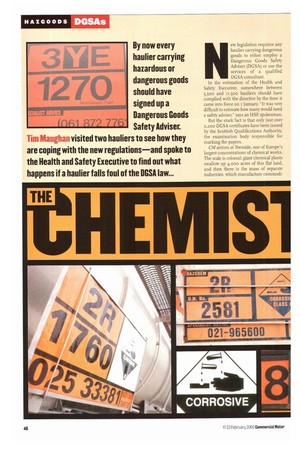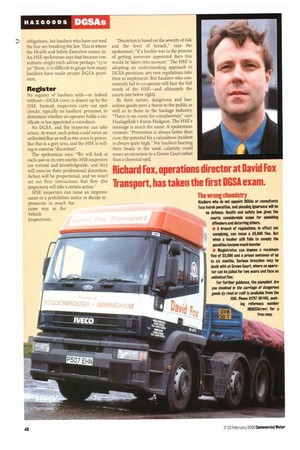THE
Page 48

Page 49

Page 50

If you've noticed an error in this article please click here to report it so we can fix it.
HEM
By now every haulier carrying hazardous or dangerous goods should have signed up a Dangerous Goods Safety Adviser. Tim Maughan visited two hauliers to see how they are coping with the new regulations—and spoke to the Health and Safety Executive to find out what happens if a haulier falls foul of the DMA law...
New legislation requires any haulier carrying dangerous goods to either employ a Dangerous Goods Safety Adviser (DG SA) or use the services of a qualified DGSA consultant. In the estimation of the Health and Safety Executive, somewhere between 5,500 and rr,soo hauliers should have complied with the directive by the time it came into force on r January. "It was very difficult to estimate how many would need a safety adviser," says an HSE spokesman.
But the stark fact is that only just over 2,200 DGS A certificates have been issued by the Scottish Qualifications Authority, the examination body responsible for marking the papers.
CM arrives at Teesside, one of Europe's largest concentrations of chemical works. The scale is colossal: giant chemical plants swallow up 4,000 acres of this flat land, and then there is the mass of separate industries, which manufacture cornmodi ties such as steel. These industries are on such a scale that 16,000 people are employed directly in Teesside's chemical plants alone. Nowhere in Britain could the subject of DGSAs be more pertinent.
Teesport-based Haulagelink runs four artics and two cement mixers; zo% of its business involves the transport of chemicals. Managing director Karen Hodgson says the chemical loads include corrosives and flammables.
Sections
She wasted no time in getting the DGSA qualification under her belt: "I did the DGSA course in April 1999," she says. "I applied early to avoid the rush, and to re-sit if I had to." There are three sections. The first is a general paper on Hazchem transport; the second covers specific classes such as radioactives or explosives; the third paper specialises in either road or rail transport. Hodgson passed all three papers first time.
"There were no past papers available, but I found it quite easy," she says. You know yourselfwhich key issues are going to be discussed. You've got to look at the broader picture and make sure you know your way around the orange ADR books."
Pass rates are running at between 50% and 70%, according to the Scottish Qualifications Authority. "The problem of most people is not that they don't know their industry, it is because they are not used to taking exams," says Hodgson. Passing the examinations gives her a twofold benefit: it dispenses with the need to employ a DGSA at the firm, and she can offer other companies her services as a consultant.
Six firms, three in Teesside and three in other parts of the country, have already signed her up. The six include both hauliers and chemical firms: the DG SA requirement covers firms manufacturing and storing Hazchem goods, not just transporting them.
In practice, Hodgson's consultancy role includes auditing the firm, drawing up a strategy plan, offering time to implement changes and then carrying out spot checks to see if the points of the strategy plan have been implemented. All this is followed by an annual audit. "Some hauliers may do just two Hazchem loads a month, so for them there is no point in appointing DGSA qualified staff," she explains. This view seems logical. Why have DGSA on site when your dangerous goo haulage represents a tiny proportion of yo business? Why not just use the services o consultant?
Candidate
David Fox Transport, based in Grangetow Middlesbrough, is involved in carryil Hazpac loads, but they account for only 5 of the work. Richard Fox, operations din tor at the firm, has taken the first DG5 exam, and at the time of writing is waith for the results.
It can be up to eight weeks before a cam date learns the outcome, so even if an opt ator has sat the exams a consultant will ha to be appointed while he is waiting for ti results. That's exactly what David Ff Transport has done. "We have the const tant for a year, and periodically he w come and audit our business," says cha man David Fox.
Fox is not surprised that so few oper tors have taken and passed the exam "With ADR the drivers sat in a room listc ing; now they have to pass tests. DGSA much more in-depth than ADR trainin and companies have to be aware of wh they are doing."
Hodgson and Fox have fulfilled the
obligations, but hauliers who have not toed the line are breaking the law This is where the Health and Safety Executive comes in. An HSE spokesman says that because consultants might each advise perhaps "15 to 3o" firms, it is difficult to gauge how many hauliers have made proper DG SA provision.
Register
No register of hauliers with—or indeed without—DGSA cover is drawn up by the HSE. Instead, inspectors carry out spot checks, typically on hauliers' premises, to determine whether an operator holds a certificate or has appointed a consultant.
No DGSA, and the inspector can take action. At worst, such action could mean an unlimited fine as well as two years in prison. But this is a grey area, and the HS E is willing to exercise "discretion".
The spokesman says: "We will look at each case on its own merits. HSE inspectors are trained and knowledgeable, and they will exercise their professional discretion. Action will be proportional, and we won't set out firm instructions that they (the inspectors) will take a certain action."
HSE inspectors can issue an improvement or a prohibition notice or decide to prosecute in much the same way as the Vehicle Inspectorate.
"Discretion is based on the severity of risk and the level of breach," says the spokesman. "If a haulier was in the process of getting someone appointed then this would be taken into account." The HSE is adopting an understanding approach to DGSA provision: any new regulations take time to implement. But hauliers who consistently fail to co-operate will face the full wrath of the HSE—and ultimately the courts (see below right).
By their nature, dangerous and hazardous goods pose a threat to the public as well as to those in the haulage industry. "There is no room for complacency," says Haulagelink's Karen Hodgson. The HSE's message is much the same. A spokesman stresses: "Prevention is always better than cure; the potential for a calamitous incident is always quite high." For hauliers burying their heads in the sand, calamity could mean an excursion to a Crown Court rather than a chemical spill.








































































































